
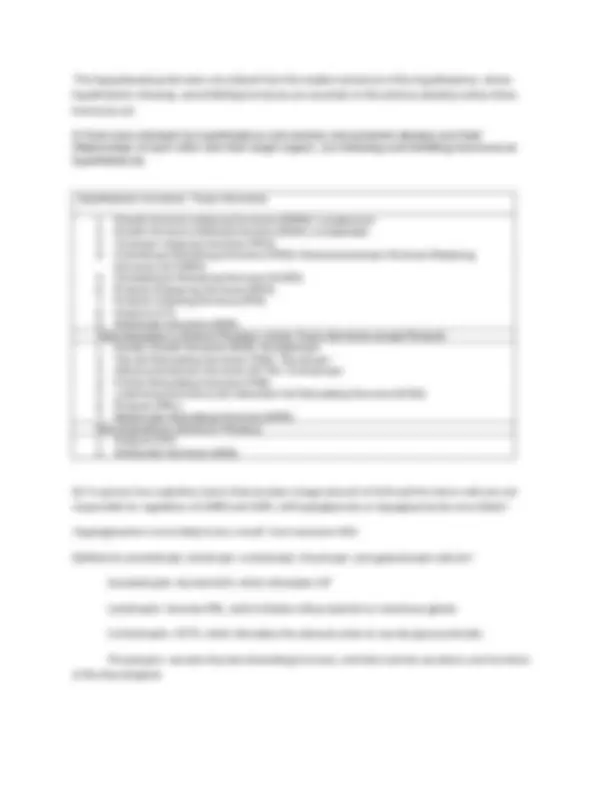
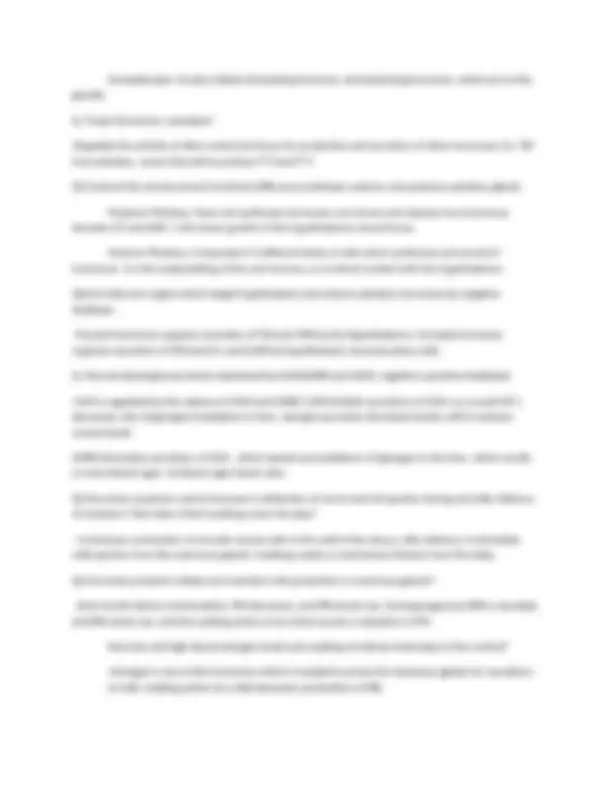
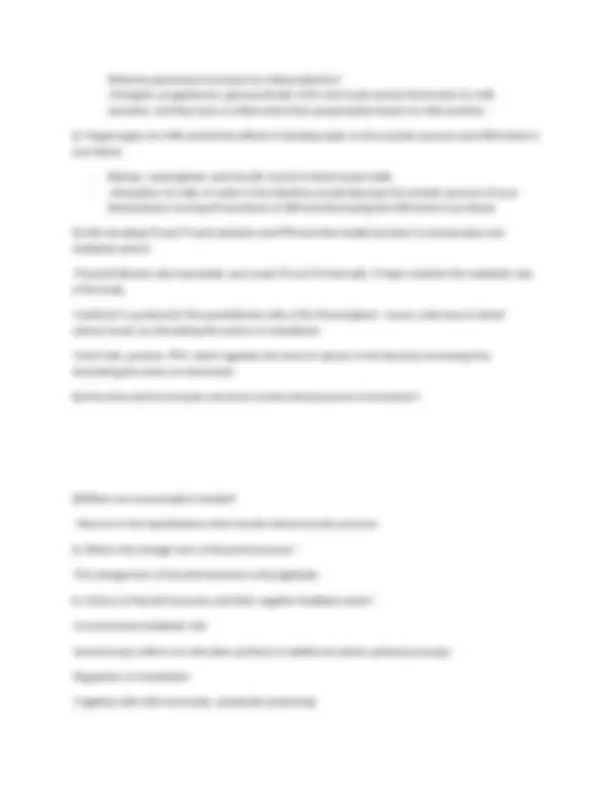
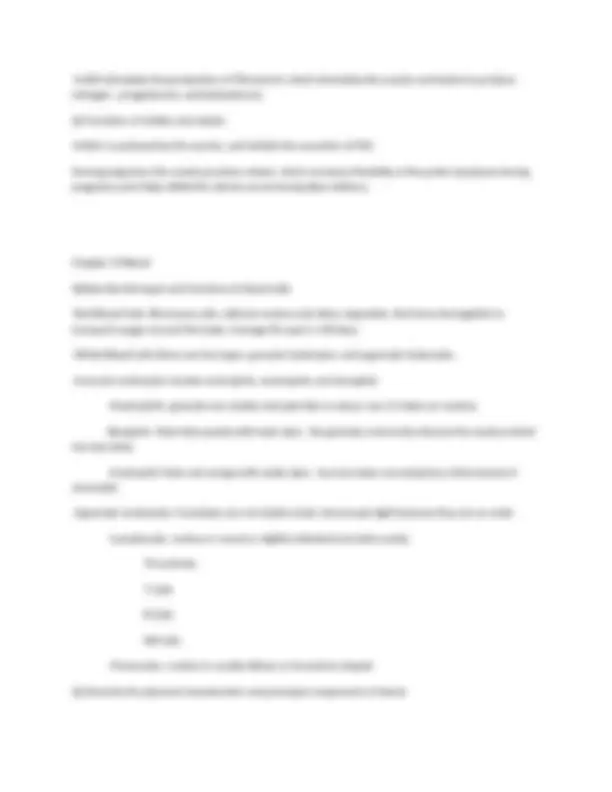
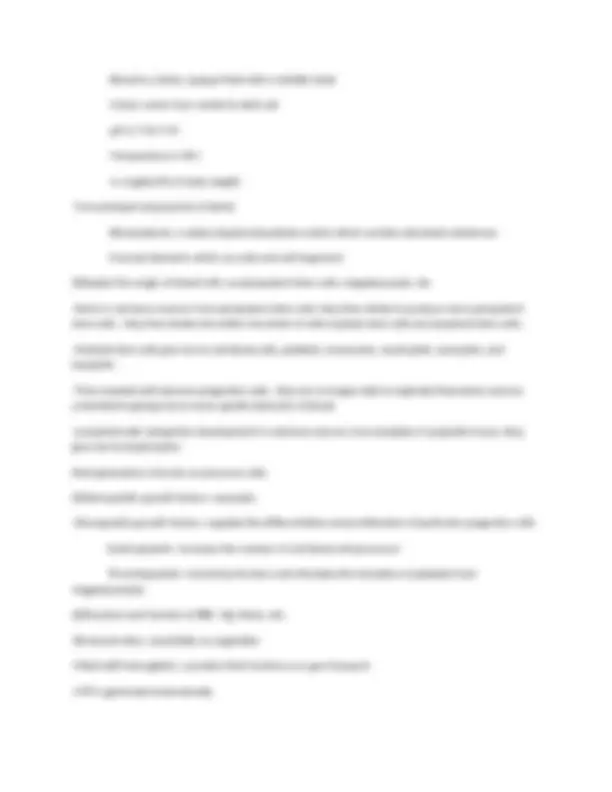
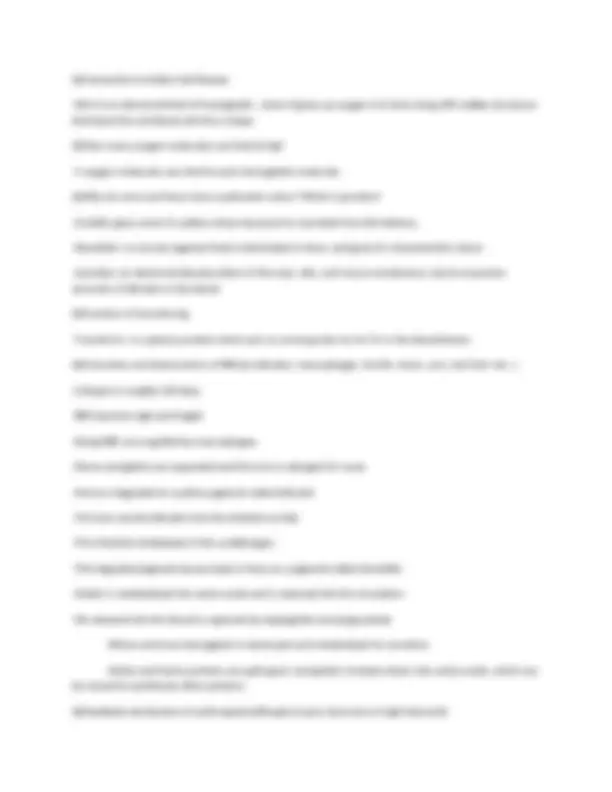



Study with the several resources on Docsity

Earn points by helping other students or get them with a premium plan


Prepare for your exams
Study with the several resources on Docsity

Earn points to download
Earn points by helping other students or get them with a premium plan
Community
Ask the community for help and clear up your study doubts
Discover the best universities in your country according to Docsity users
Free resources
Download our free guides on studying techniques, anxiety management strategies, and thesis advice from Docsity tutors
Exam 1 Material Type: Notes; Professor: Lee; Class: Anatomy & Physiology I Lecture; Subject: Biology; University: Gordon College;
Typology: Study notes
1 / 13

This page cannot be seen from the preview
Don't miss anything!








Exam 1 Study Guide Q:Compare the similarities and the differences in the endocrine and nervous system in maintain homeostasis? -Both act together to coordinate functions of the body systems. -Nervous system sends action potentials through axons to dendrites, and is a relatively closed system. -The endocrine system sends signals via chemicals known as hormones, which unlike nerve impulses, must enter the blood, and are secreted at one area of the body, and affect the target cells in another. Q: Compare the functional differences of autocrines and paracrines and their examples.
Water-Soluble Hormones 1)Binds to membrane, activates G Protein 2)ATP converted to cAMP on inner membrane 3)Activates protein kinase in cytosol 4)Phosphorylation activates proteins in cell like on or off switch 5)Causes reactions that produce physiological changes 6)After brief period of time, cAMP is turned off Q)How are they transported in the blood. Water-Soluble- Most flow through the watery blood plasma in free form, not attached to molecules. Lipid Soluble- Need to be bound to transport proteins in the blood Q: What is the action of the receptor-hormone complex in lipid soluble hormone? -The receptor hormone complex alters gene expression by turning specific genes within the nucleus on and off. Q:Why is cAMP called a second messenger protein? -Because water-soluble hormone must bind to the surface membrane, and activate cAMP by G Protein, and cAMP is basically the one within the cell that does produces the effect of the hormone. Q)What three types of signals control hormone secretion? -Signals from the nervous system -Chemical changes in the blood -Other hormones Q) What is the function of G Protein in generating a “second messenger” of cAMP or Ca++? -G Protein activate adenylate cyclase. Which converts ATP into cAMP. Q)What is the functional importance of the hypophyseal portal veins?
Gonadotrophs- Scretes follicle stimulating hormone, and luteinizing hormone, which act on the gonads. Q: Tropic Hormones, examples? -Regulate the activity of other endocrine tissue for production and secretion of other hormones. Ex. TSF from pituitary, causes thyroid to produce T^3 and T^ Q) Contrast the structural and functional differences between anterior and posterior pituitary glands. Posterior Pituitary- Does not synthesize hormones, but stores and releases two hormones. Secretes OT and ADH. Is the down growth of the hypothalamus neural tissue. Anterior Pituitary- Composed of 5 different kinds of cells which synthesize and secrete 9 hormones. It is the outpocketing of the oral mucosa, so no direct contact with the hypothalamus. Q)List endocrine organs which target hypothalamic and anterior pituitary hormones by negative feedback. -Thyroid hormones suppress secretion of TSH and TRH by the Hypothalamus. Gonadal hormones suppress secretion of FSH and LH, and GnRH by hypothalamic neurosecretory cells. Q: How do blood glucose levels maintained by hGH(GHRH and GHIH, negative a positive feedback) -hGH is regulated by the release of GHIH and GHRH, GHIH inhibits secretions of hGH, as a result IGF’s decreases rate of glycogen breakdown in liver, and glucose enters the blood slowly until it reachers normal levels. GHRH stimulates secretions of hGH, which speeds up breakdown of glycogen in the liver, which results in more blood sugar. So blood sugar levels raise. Q) How does oxcytocin control increase in distention of cervix and mil ejection during and after delivery of newborn? How does infant suckling come into play?
What are permissive hormones for milk production? -Estrogens, progesterone, glucocorticoids, hGH, and insulin primes the breasts for milk secretion, and they have no effect other then preparing the breast for milk secretion. Q: Target organs for ADH and list the effects of drinking water on the osmotic pressure and ADH levels in your blood.
Q:Where and by what cells release rennin? -Cells in the kidneys, called juxtaglomerular cells, secrete the enzyme rennin. Q: What is the function of rennin? -Renin converts angiotensinogen, a plasma protein produced by the liver, into angiotensin II. Q) Explain short term and long term stress response. -Fight or flight- quickly mobilizes the body’s resources for immediate physical activity. -Resistance reaction- longer lasting response, -Exhaustion- when the resources of the body become so depleted that they cannot sustain the resistance phase. Q:Alarm reaction(epinephrine and norepinephrine) resistance reaction( ACTH, GHRH, and TRH). What are their effects on blood glucose. -Epinephrine and norepinephrine, are used in the fight or flight response, and cause occur only during stressful situations, it causes blood glucose levels to rise. -ACTH, GHRH, and TRH: CRH stimulates the release of ACTH during flight or flight, that causes the adrenal cortex to release cortisol, which causes liver cells to breakdown triglycerides into fatty acids, tissue throughout the body used the glucose that was created. -And then, GHRH, causes secretions of hGH, acting via IGF, causes breakdown of glycogen into glucose, and THR causes thyroid to stimulate TSH, which stimulate increase use of glucose for ATP production. Q) What is meant by “ beta cell burn-out? -Type 2 Diabetes from when the body has excessive insulin and can no longer process it normally Q)Pancreatic islet cells and hormones for glucose homeostatsis(insulin, glucagon, somatostatin, and their metabolic effects:glyogenolysis, gluconeogenesis, and glycogenesis) -Alpha cells secrete glucagon which raises blood glucose levels -Beta cells secrete insulin which lowers blood glucose levels -Delta Cells somatostatin which acts in a paracrine manner to inhibit both insulin and glucagon release from neighboring beta and alpha cells -F cells secrete pancreatic polypeptide which inhibits somatostatin secretion, gall bladder contraction, and secretion of digestive enzymes by the pancreas Q) Know the relationship with GnRH, FSH, LH, estrogen, progesterone, and testosterone.
-GnRH stimulates the production of FSH and LH, which stimulates the ovaries and testes to produce estrogen , progesterone, and testosterone. Q) Functions of inhibin and relaxin. Inhibin is produced by the ovaries, and inhibits the secretion of FSH. During pregnancy the ovaries produce relaxin, which increases flexibility of the pubic symphysis during pregnancy and helps dilate the uterine cervix during labor delivery Chapter 19 Blood Q)Describe the types and functions of blood cells -Red Blood Cells- Biconcave cells, without nucleus and other organelles, that have hemoglobin to transport oxygen around the body. Average life span is 120 days -White Blood Cells there are two types, granular leukocytes, and agrenular leukocytes. -Granular Leukocytes include neutrophils, eosinophils, and basophils -Neutrophils- granules are smaller and pale lilac in colour, has 2-5 lobes on nucleus. Basophils- Stain blue purple with basic dyes, the granules commonly obscure the nucleus which has two lobes -Eosinophil- Stain red orange with acidic dyes, has two lobes connected by a thick strand of chromatin. -Agranular Leukocytes- Grandules are not visible under microscopic light because they are so small. -Lymphocyte- nucleus is round or slightly indented and stains easily. Three Kinds T Cells B Cells NK Cells -Monocytes- nucleus is usually kidney or horseshoe shaped. Q) Describe the physical characteristics and principal components of blood.
Q)Connection to Sickle Cell Disease -Hb-S is an abnormal kind of hemoglobin , when it gives up oxygen is it forms long stiff rodlike structures that bend the red blood cell into a shape Q)How many oxygen molecules can bind to Hg? -4 oxygen molecules can bind to each hemoglobin molecule. Q)Why do urine and feces have a yellowish colour? What is jaundice? -Urobilin gives urine it’s yellow colour because it is secreted from the kidneys. -Sterobilin- is a brown pigment that is eliminated in feces, and gives it’s characteristic colour. -Jaundice- an abnormal discolouration of the eyes, skin, and mucus membranes, due to excessive amounts of bilirubin in the blood. Q)Function of transferring -Transferrin- is a plasma protein which acts as a transporter for Fe^3+ in the bloodstream. Q)Formation and desctruction of RBC(ex-bilirubin, macrophages, ferritin, feces, urin, and Fe2+ etc. ). -Lifespan is roughly 120 days -RBS become rigid and fragile -Dying RBC are engulfed by macrophages- -Heme and globin are separated and the iron is salvaged for reuse -Heme is degraded to a yellow pigment called bilirubin -The liver secrete bilirubin into the intestine as bile -The Intestine metabolize it into urobilinogen -This degraded pigment leaves body in feces as a pigment called sterobilin -Globin is metabolized into amino acids and is released into the circulation -Hb released into the blood is captured by haptoglobin and phgocytized Where and how hemoglobin is destroyed and metabolized for secretion Globin and heme portions are split apart, and globin is broken down into amino acids, which can be reused to synthesize other proteins. Q)Feedback mechanism of erythropoiesis(People in peru have low or high hemocrit)
-If oxygen carrying capacity of the blood falls, because erthyopoiesis is not keeping up with RBC destruction, then a negative feedback system steps us RBC production. -Once your move to a high altitude your hematocrit would increase due to increased secretion of erythropoietin. Q)Functions of Granular or Agranular leukocytes(high or low count means?) -Help fight infection in immune responses such as bacteria, viruses, fungi, and allergic reactions. -Higher counts can indicate infections, lower counts can be stress on the body. Q)Selectin and integrins on emigrations of WBC -Selectins- are adhesion molecules in response to nearby injury or inflammation. They stick to carbohyrdrates on the surface of neutrophils and causing them to slow down and roll along the endothelial surface. -Integrins- adhesion molecules located on the neutrophil surface, which tether them to the endothelium and assist in their movement through blood vessel wall and into the interstitial fluid of injured tissue. Q) What is a differential white blood cell count? -Used to count the type of each white blood cells in the body, for infection of inflammation. Because each WBC has a specific response and target it can help diagnose symptoms. Q)Describe the three mechanisms that contribute to hemostasis(vascular spasms, platelet plus formation, and coagulation) -Hemostasis- a sequence of response that stops bleeding. Vascular Spasm- When arteries are damaged the smooth muscle in their walls contracts immediately, reduces blood loss for several minutes to hours while other mechanisms come into play. -Platelet Plug Formation, is limited only to the immediate area of injury
Hemolytic disease of the newborn(HDN), why is the firstborn baby unlikey to have HDN?